Menus
- Fun bike with 70 hp, 140 kilograms, 210 km / h
- Just no cables in sight!
- Radical single racer and relaxed naked version
- Development of the Target 320
- MOTORRAD prototypes
- Suzuki RG BIG 750
- Yamaha Supertwin 850
- Yamaha Roadstar 535
- Yamaha Sportstar R1
- Honda NR 600 RR
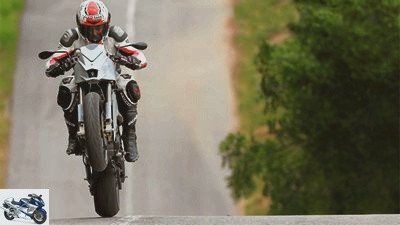
Jahn
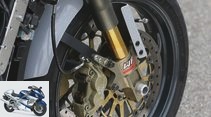
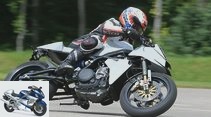

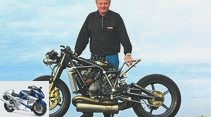
25th photos
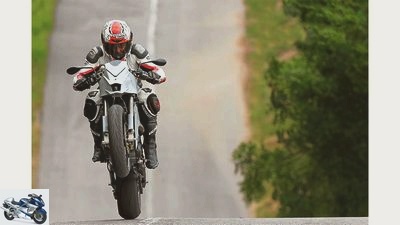
Jahn
1/25
The narrow cladding with a small light shaft between the spoilers characterizes the front view of the sports version.
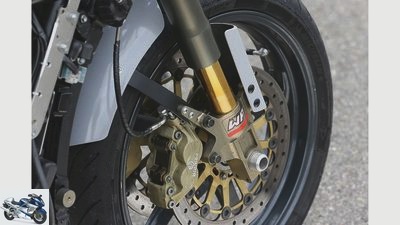
Jahn
2/25
Bembo brake.
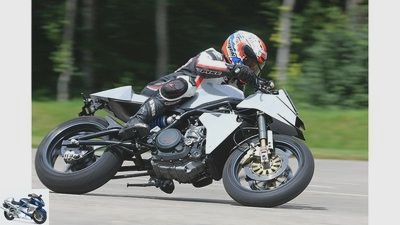
Jahn
3/25
Full speed ahead.
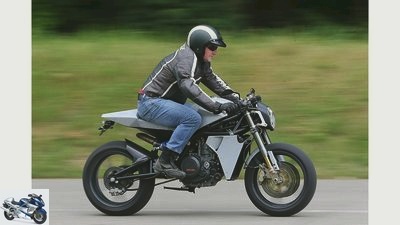
Jahn
4/25
The base of the Target 320 could also be used for a nice jet helmet cruiser.
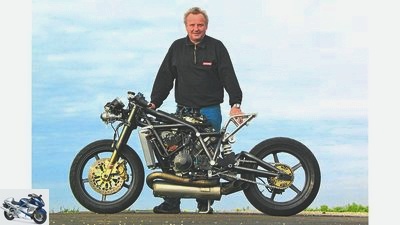
Jahn
5/25
The basis: In 2003, KTM developed the first prototype for the RC8, at that time still with a 990 engine. The 690 single was implanted in this chassis, which was born at the UN in Augsburg.
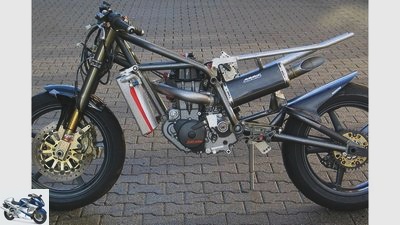
Jahn
6/25
In just three days, the 690 engine was in the chassis, which is now around two kilograms lighter and more compact with a new rear frame and without spring strut redirection.
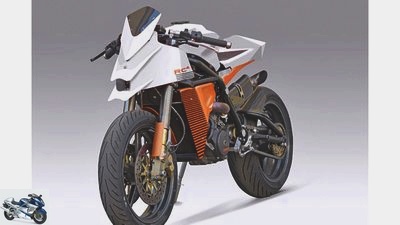
Jahn
7/25
MOTORRAD graphic artist Stefan Weber gave the Target 320 a very fine, subtle “paint job” on the PC, which will be implemented in the next expansion stage.
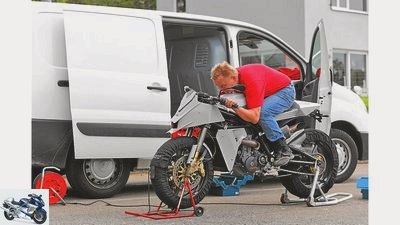
Jahn
8/25
“Fits!” The seat rehearsal shortly before the maiden voyage brought no new knowledge, but it looks extremely important.
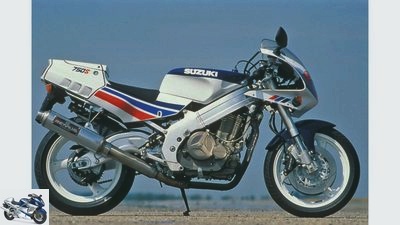
Jahn
9/25
Prototypes from MOTORRAD: Building prototypes has a long tradition at MOTORRAD and has made many manufacturers wonder. Here the Suzuki RG BIG 750. The chassis of the RG 250, paired with the 50 HP four-stroke single cylinder of the Enduro, was created at a time when fast singles were booming. The 181 kg athlete was a topic at Suzuki / Japan and worth an article in the Suzuki customer magazine.
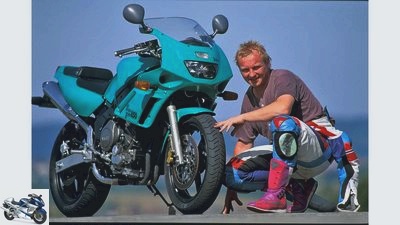
Jahn
10/25
Here the Yamaha Supertwin 850. Even before Ducati pushed the 916 onto the market, MOTORRAD built the 85 HP sports car with a TDM 850 engine in the FZR 600 chassis in 1992 in cooperation with Yamaha / Europe. A few years
later the idea came back from Japan as the Yamaha TRX 850.
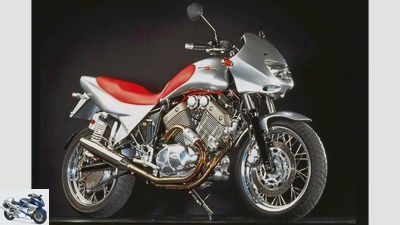
Jahn
11/25
The Yamaha Roadstar 535. The bestseller XV 535 has been radically rebuilt and is agile and manageable with a sporty chassis. With seat height adjustment, variable ergonomics and the fine V2 motor with cardan gear, the BT 1100 Bulldog followed. Unfortunately without success.
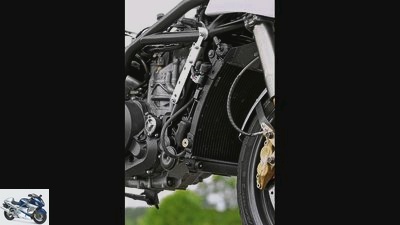
Jahn
12/25
Tall and narrow: arched water cooler, rotated 90 degrees.
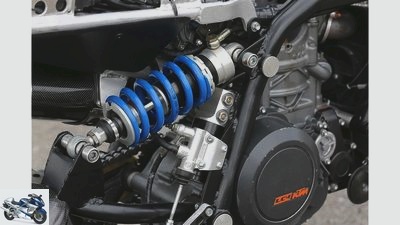
Jahn
13/25
So that the engine ultimately becomes a complete motorcycle, KTM head of development Philipp Habsburg presented us with the first RC8 prototype as an organ donor in the MOTORRAD workshop.

Jahn
14/25
Fine thing: 43 WP GP fork with adjustable offset for the caster.
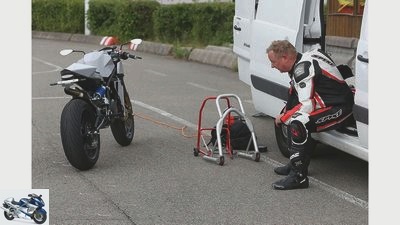
Jahn
15/25
The finished work can be admired calmly.
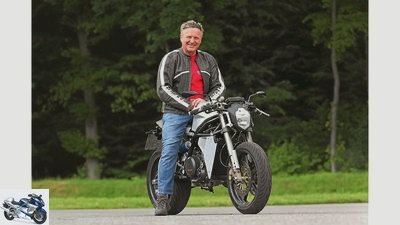
Jahn
16/25
MOTORRAD editor Werner “Mini” Koch and his naked version, a modern Yamaha SRX-6 so to speak.
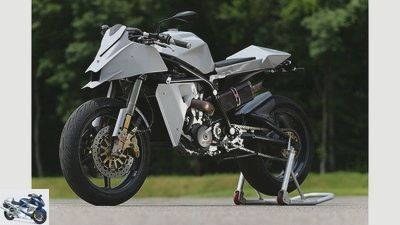
Jahn
17/25
The fact that the Target 320 was designed as a representative of the sporting line is of course primarily due to its own resume. A full 25 years of racing, with a preference for the smaller classes, leave their mark.
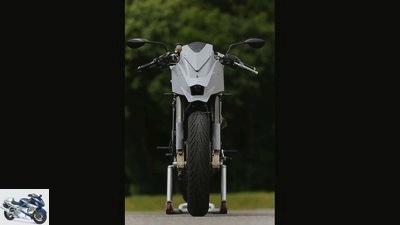
Jahn
18/25
Robust, over 70 hp and light, exactly the right base for the Target 320.

Jahn
19/25
It goes without saying that the angular, minimalist design is based on the KTM models.
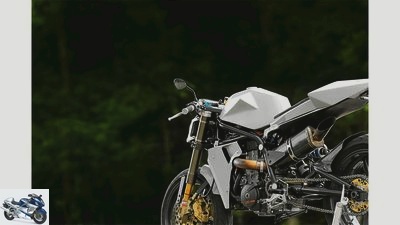
Jahn
20/25
The motto was: as little as possible, as much as necessary.
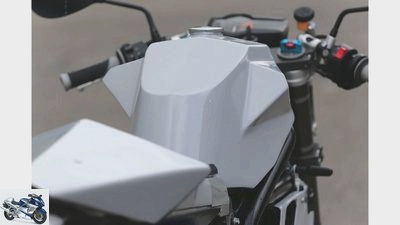
Jahn
21/25
The self-construction stands out due to its angular construction.
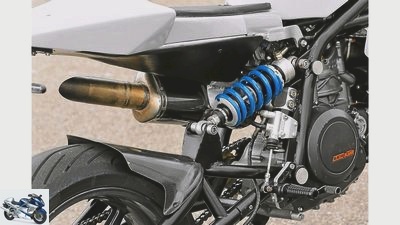
Jahn
22/25
Tight crowd: shock absorber and brake pump in a very small space
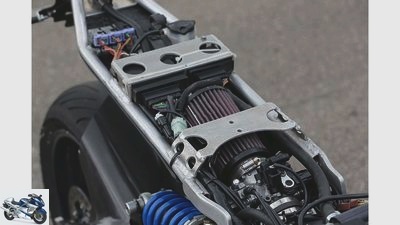
Jahn
23/25
Air filters can be found under the seat…

Jahn
24/25
… and electronics place.

Jahn
25/25
The Yamaha Sportstar R1. The 145 HP motor in the UNO chassis suitable for touring made the Sportstar the first power naked bike in 1998. Equipped with 208 kilograms, a 24-liter tank, toothed belt drive and a variable ergonomics package, the prototype was followed by the Yamaha FZS 1000 Fazer.
KTM Target 320 MOTORRAD self-made
Fun bike with 70 hp, 140 kilograms, 210 km / h
Too much power, too much weight, too much trimmings. With the self-made KTM Target 320, MOTORRAD editor Werner “Mini” Koch is trying to redefine the key data for pure driving pleasure: 70 hp, 140 kilograms, 210 km / h – that should be enough.
D.hat had to come like that. After the exuberant response from MOTORRAD readers to the design of a BMW R 95 G / S (in MOTORRAD 5/2012) with an intended weight of 190 kilograms and 90 hp, the call for a new generation of motorcycles can no longer be ignored. A generation that focuses on enjoyable, light-footed motorcycling again. Away from striving for more power and more high-tech, towards the feather-light driving machine with solid, manageable technology and maximally reduced plastic fiddling. Motorcycles to look at, to touch, to fall in love with.
Buy complete article
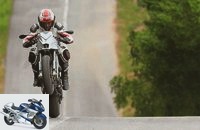
KTM Target 320 MOTORRAD self-made
Fun bike with 70 hp, 140 kilograms, 210 km / h
Robust and over 70 hp




25th photos
Pictures: KTM Target 320 MOTORRAD self-made
To home page
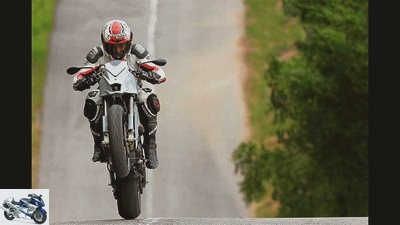
Jahn
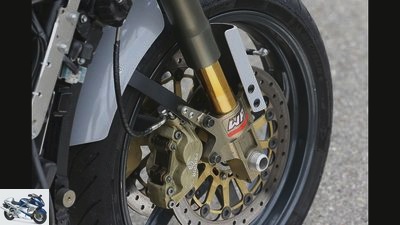
Jahn
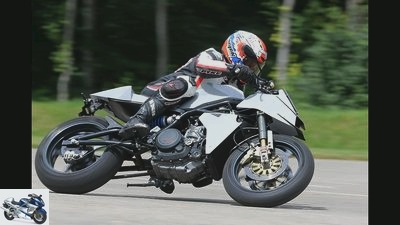
Jahn
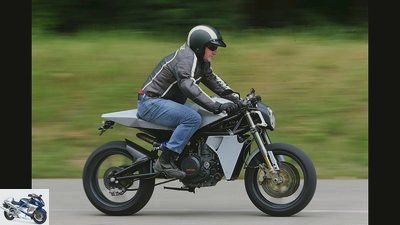
Jahn
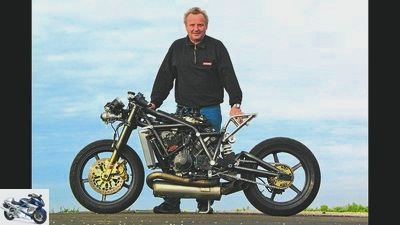
Jahn
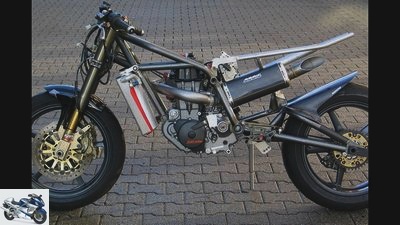
Jahn
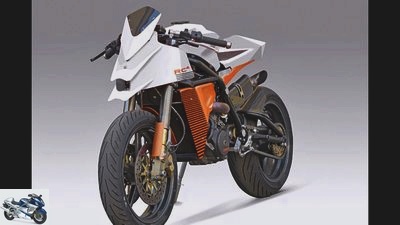
Jahn
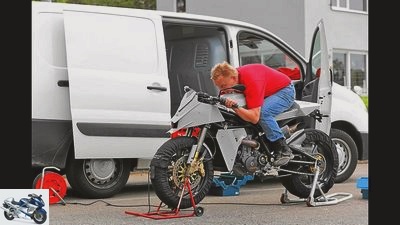
Jahn
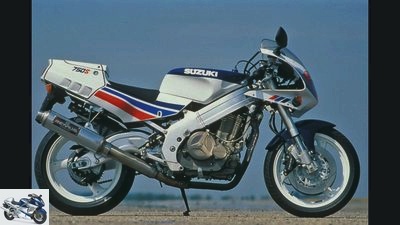
Jahn
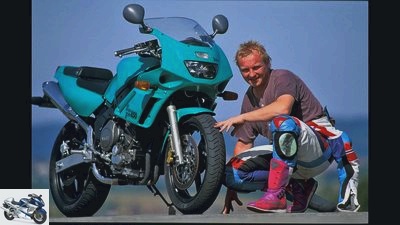
Jahn
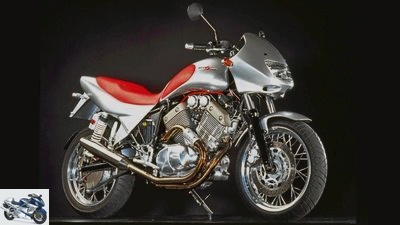
Jahn
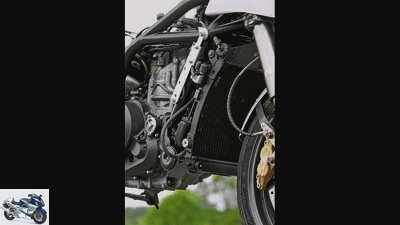
Jahn
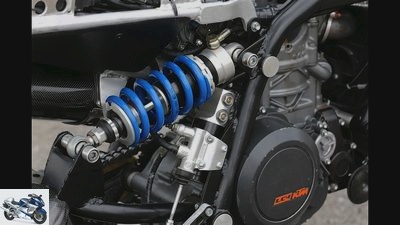
Jahn
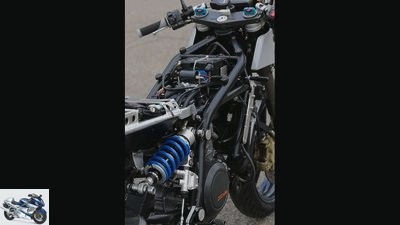
Jahn
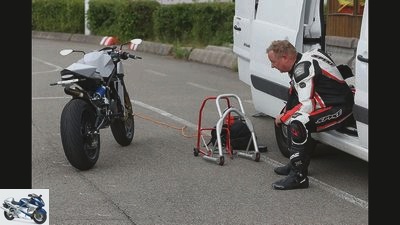
Jahn
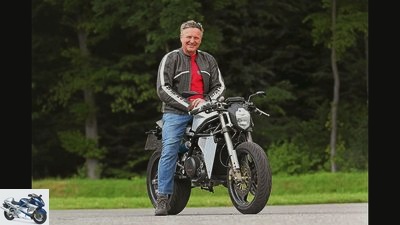
Jahn

Jahn
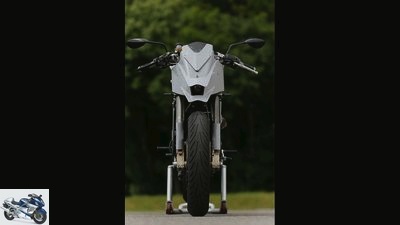
Jahn
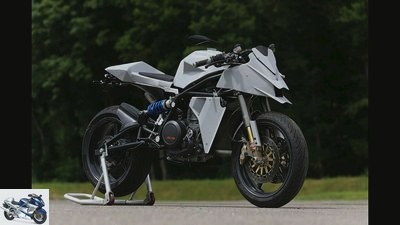
Jahn
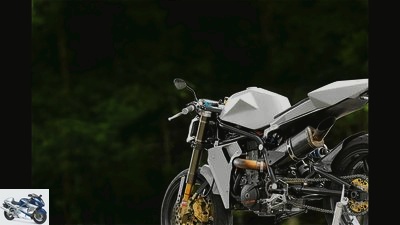
Jahn
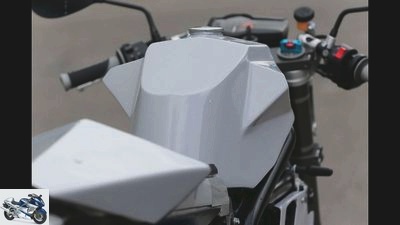
Jahn
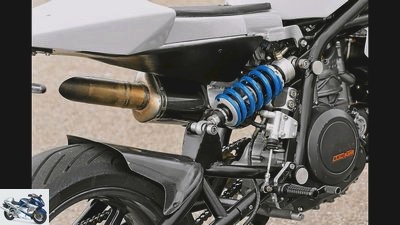
Jahn
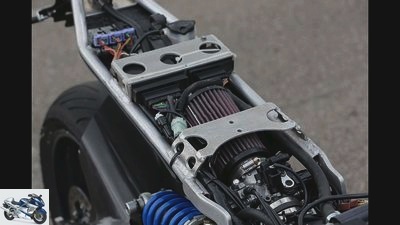
Jahn
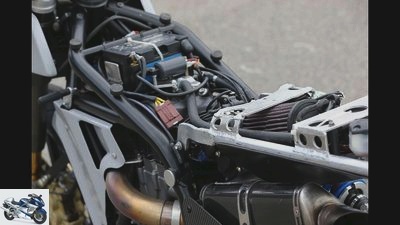
Jahn
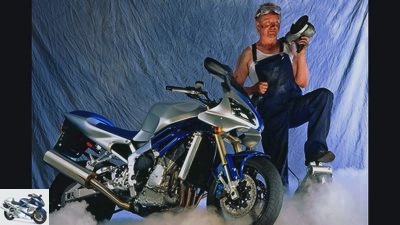
Jahn
First measure, tinker, sketch, and then radically fit the 690 engine with Flex and hacksaw, that’s the only way to get ahead. The Single is not quite as solidly screwed into the frame as the V2 engine, which is why a few subsequently welded reinforcements and gusset plates are required to maintain the load-bearing function of the engine. After several night shifts, the welded tubular steel frame, together with the 690 engine, is on the workbench. Well then, go.
What does not work is the cooler, which puffs up the slim design to a standard width. Why are the beautiful, arched coolers always installed across? Upright is also possible. And whoosh, the radiator, rotated by 90 degrees, disappears behind the fork bars and tapers the front view to the dimensions of an air-cooled moped. Which brings us a big step closer to the goal, after all, the name “Target 320” also says it all. Because the single must not be wider than 320 millimeters. And not much bigger than a 250 either.
Just no cables in sight!
So downsizing across the board. However, this means that everything from the aluminum tank to the bench seat to the frame-mounted front paneling – the spoiler face of which is an excellent argument – has to be redrawn and the GRP parts have to be laminated out of negative aluminum molds. A tedious and dusty affair that messes up the schedule for the project.
Jahn
The fact that the Target 320 was designed as a representative of the sporty line is of course primarily due to its own resume. A full 25 years of racing, with a preference for the smaller classes, leave their mark.
As if the shaping and modeling didn’t take enough time, the WP fork and Wilbers shock absorber also have to be completely rebuilt because the coordination and overall lengths are completely new and, above all, have to be adapted to the target weight of 140 kilograms. You are also amazed when it comes to stowing the necessary electrical and electronic components of a single-cylinder engine. Two electronics boxes, half a dozen relays, switches, fuses and connectors – where to put them? In the last gap, hidden between the radiator and the air scoop, under the seat rump, everywhere, but please not in the field of vision.
So that the slim line runs through from front to back, only a central support tube is installed on the aluminum frame rear, which leaves enough space for the silencer and the shock absorber, which is directly linked to the tubular steel swing arm. This clearly defines the purpose of the Target 320, because under the load of a pillion passenger or a fat luggage system, the aluminum construction would simply collapse. After a good 300 working hours and a lot of support from the indispensable specialists and specialists, the Target 320, freshly painted and in two versions, rolls for the first photo ride.
Radical single racer and relaxed naked version
At the beginning, the clear objective of the super-sporty, radical single racer was still on the plan, but in line with the trend towards casual jet helmet cruising, the bare version with a chic LSL headlight has also been added. From the outset, more comfortable and relaxed than excruciatingly sporty, you hardly have to compromise on ergonomics. Height-adjustable footrests and LSL match handlebars in conjunction with the short tank prevent physical dislocations. In the upcoming first optimization phase, of course, the seat cushion will get at least two more layers of foam.
Jahn
Tight crowd: there is space for air filters and electronics under the seat.
The fuel bubbles into the tank with a chuckle – it is actually tight. Put the key in, turn it, it hums and hums, the cockpit shows no error, enables the start. Two or three wrong tones, then ignition and injection come together, from the sloping side pipe it thunders audibly, clearly and healthy. Then the gray mouse picks up speed. Feels good, but kind of weightless, like the engine is missing. But it’s inside and pushes neatly forward.
Feel the first corner, gently sloping. Still doesn’t feel like anything. No resistance, no mass, no nothing at all. I know the feeling, but it was a long time ago. Back when we were still lifting motorcycles into the van by hand. That was great, I want to go back there. There is still a lot to be done before the Target 320 is not only light as a feather, but also bomb-proof, fast and safe. Here, too, the old rule applies: easy is difficult to vote. Whether and how it works Soon in this theater or at motorradonline.de.
Development of the Target 320
Jahn
The basis: In 2003, KTM developed the first prototype for the RC8, at that time still with a 990 engine. The 690 single was implanted in this chassis, which was born at the UN in Augsburg.
It took two years for the KTM RC8 prototype to mutate into the Target 320. From a flippant remark – “the cool LC4 motor also belongs in a cool chassis” – I inherited a huge construction site that really got on my nerves. It is not the very radical changes such as the frame, spring elements or the self-made aluminum tank, but the fiddling work, such as changing wiring harnesses, wiring lighting systems, grinding polyester parts, filling, grinding, filling. All the more beautiful the moment when the thing stands there, completely painted, and hums.
In just three days, the 690 engine was in the chassis, which is now round with a new rear frame and no strut deflection
two kilograms lighter and more compact.
MOTORRAD prototypes
Jahn
MOTORRAD editor Werner “Mini” Koch and his naked version, a modern Yamaha SRX-6 so to speak.
Building prototypes has a long tradition at MOTORRAD and has puzzled many manufacturers. The advantage of the handcrafted projects: We didn’t have to consider production costs or market analyzes. Maybe that’s why a couple of really great bikes were created.
Suzuki RG BIG 750
Jahn
Suzuki RG BIG 750.
The chassis of the RG 250, paired with the 50 hp four-stroke single cylinder of the Enduro, was created at a time when fast singles were booming. The 181 kg athlete was the subject of Suzuki / Japan and an article in Suzuki-
Customer magazine worth it.
Yamaha Supertwin 850
Jahn
The Yamaha Supertwin 850.
Even before Ducati pushed the 916 onto the market, MOTORRAD built the 85 hp sports car with a TDM 850 engine in the FZR 600 chassis in 1992 in cooperation with Yamaha / Europe. A few years later the idea came back from Japan as the Yamaha TRX 850.
Yamaha Roadstar 535
Jahn
The Yamaha Roadstar 535.
The bestseller XV 535 has been radically rebuilt and made agile and manageable with a sporty chassis. With seat height adjustment, variable ergonomics and the fine V2 motor with cardan gear, the BT 1100 Bulldog followed. Unfortunately without success.
Yamaha Sportstar R1
Jahn
The Yamaha Sportstar R1.
The 145 HP motor in the UNO chassis suitable for touring made the Sportstar the first power naked bike in 1998. Equipped with 208 kilograms, a 24-liter tank, toothed belt drive and a variable ergonomics package, the prototype was followed by the Yamaha FZS 1000 Fazer.
Honda NR 600 RR
Radically dedicated to racing, in 2000 the 176 kilogram lightweight NR 600 became what is now known as Moto2 and thrills fans. Back then, too, MOTORRAD used the Honda CBR 600 engine as a drive in the optimized aluminum chassis with NSR 500 fairing.
Related articles
-
fact 29 pictures fact 1/29 fact 2/29 fact 3/29 fact 4/29 fact 5/29 fact 6/29 fact 7/29 fact 8/29 fact 9/29 fact 10/29 fact 11/29 fact 12 / 29 fact 13/29 fact …
-
BMW Motorrad K 1600 GT from 2012 – Technical data
BMW Motorrad K 1600 GT technical data from 2012 Technical specifications engine Number of cylinders, type 6, in-line engine power 118.0 kW / 160.5 hp at…
-
BMW Motorrad K 1600 GTL from 2012 – Technical data
BMW Motorrad K 1600 GTL technical data from 2012 Technical specifications engine Number of cylinders, type 6, in-line engine power 118.0 kW / 160.5 hp at…
-
BMW Motorrad K 1600 GT from 2014 – Technical data
BMW Motorrad K 1600 GT technical data since 2014 Technical specifications engine Number of cylinders, type 6, in-line engine power 118.0 kW / 160.5 hp at…
-
BMW Motorrad K 1600 GT from 2013 – Technical data
BMW Motorrad K 1600 GT technical data from 2013 Technical specifications engine Number of cylinders, type 6, in-line engine power 118.0 kW / 160.5 hp at…
-
First driving report of the Kawasaki GPZ 900 R (MOTORRAD 1-1984)
Archive 26 pictures Archive 1/26 Light, strong and fast was the formula for the Kawasaki superbike of the 1980s, the GP Z 900 R. Archive 2/26 According to …
-
Self-made Honda CBX “RC166” from 1966
Jahn 19 pictures Jahn 1/19 self-made: Honda CBX RC166, based on a CBX 1000. Jahn 2/19 self-made: Honda CBX RC166 without fairing. Jahn 3/19 …
-
BMW Motorrad K 1600 GTL from 2013 – Technical data
BMW Motorrad K 1600 GTL technical data from 2013 Technical specifications engine Number of cylinders, type 6, in-line engine power 118.0 kW / 160.5 hp at…
-
BMW Motorrad K 1600 GTL from 2011 – Technical data
BMW Motorrad K 1600 GTL technical data from 2011 Technical specifications engine Number of cylinders, type 6, in-line engine power 118.0 kW / 160.5 hp at…
-
On the move with the MV Agusta Target
Gargolov 34 photos Gargolov 1/34 MV Agusta Target. Gargolov 2/34 MV Agusta Target. Gargolov 3/34 MV Agusta Target. Gargolov 4/34 MV Agusta Target….